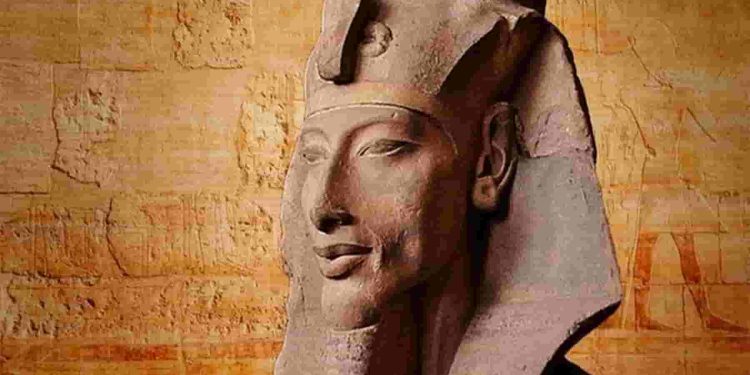A Radical Transformation: Monotheism in Ancient Egypt
Akhenaten, an 18th Dynasty pharaoh of Egypt’s New Kingdom, is one of history’s most controversial rulers. His reign, which lasted from 1353 to 1336 BC, was marked by a radical religious transformation. The king abandoned traditional Egyptian polytheism and introduced monotheism, worshiping the sun god Aten exclusively.
The Amarna Revolution: A New Capital and Artistic Style
In an unprecedented move, he relocated the capital from Thebes to Amarna, a city he built in honor of Aten. This shift, known as the Amarna Revolution, brought about significant changes in Egyptian society, including a new artistic style that focused on naturalism and depictions of the royal family in everyday life.
Family Matters: The Enigmatic Nefertiti and Tutankhamun
Akhenaten’s family life was equally fascinating. His wife, Nefertiti, was a powerful queen who may have co-ruled with him. The couple had six daughters, but the parentage of their presumed son, Tutankhamun, remains a mystery. Some speculate that Akhenaten fathered Tutankhamun with one of his sisters, while others suggest Nefertiti bore the future king.
His Legacy: A Brief Reign, But a Lasting Impact
Though Akhenaten’s reign was short-lived, his religious reforms and artistic innovations left an indelible mark on ancient Egypt. After his death, traditional polytheism was restored, and Amarna was abandoned. Yet, the legacy of Akhenaten’s revolutionary ideas persisted, influencing subsequent rulers and shaping modern perceptions of the enigmatic pharaoh.
A Bold Experiment: Akhenaten’s Religious Reforms
Akhenaten’s monotheistic revolution represented a significant departure from the centuries-old religious practices of ancient Egypt. By elevating the sun god Aten above all other deities, the king rejected the traditional pantheon and priesthood, a move that disrupted the social order and likely made him many enemies.
Artistic Innovations: The Amarna Style
The Amarna period witnessed a significant transformation in Egyptian art. Akhenaten’s artists embraced a more naturalistic approach, depicting the royal family with elongated, androgynous features and capturing intimate moments of their daily lives. This unique artistic style, known as the Amarna Style, was a stark contrast to the rigid and idealized depictions of pharaohs that dominated ancient Egyptian art for centuries.
The Mystery of Nefertiti: A Powerful and Enigmatic Queen
Nefertiti, Akhenaten’s chief wife, played a significant role during his reign. She appeared alongside the pharaoh in religious ceremonies and may have even held the status of a co-regent. However, her fate after Akhenaten’s death remains a mystery, with some scholars suggesting she may have ruled as pharaoh under the name Neferneferuaten.
The Boy King: Tutankhamun’s Connection to Akhenaten
The relationship between Akhenaten and Tutankhamun, one of history’s most famous pharaohs, remains an enigma. Though many believe Akhenaten was Tutankhamun’s father, the identity of the boy king’s mother is uncertain. Tutankhamun’s brief reign marked a return to traditional Egyptian religion and the abandonment of Amarna, further highlighting the controversial nature of Akhenaten’s rule.











